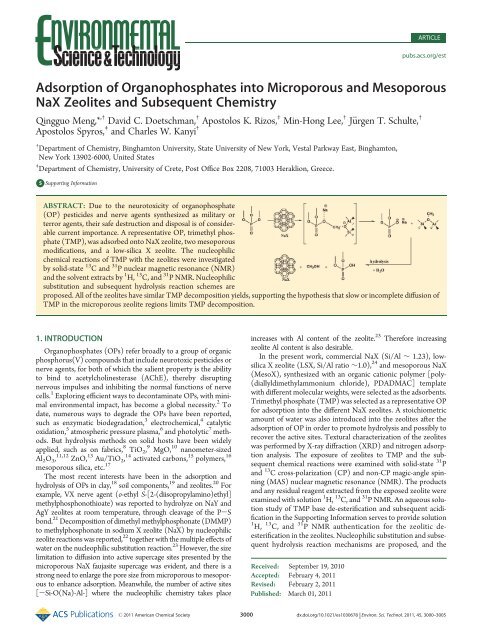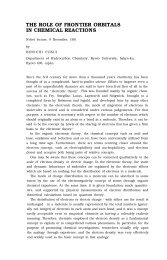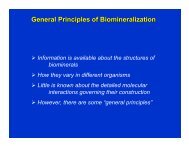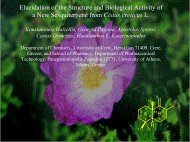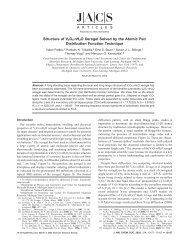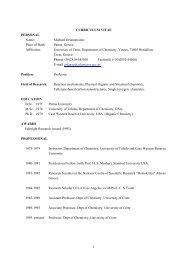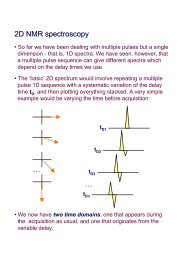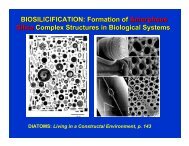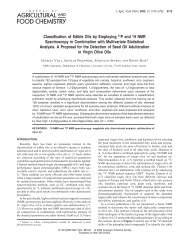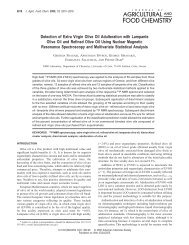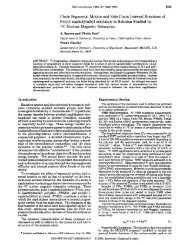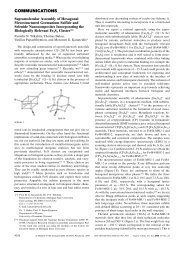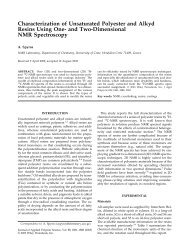Adsorption of Organophosphates into Microporous and Mesoporous ...
Adsorption of Organophosphates into Microporous and Mesoporous ...
Adsorption of Organophosphates into Microporous and Mesoporous ...
You also want an ePaper? Increase the reach of your titles
YUMPU automatically turns print PDFs into web optimized ePapers that Google loves.
ARTICLEpubs.acs.org/est<strong>Adsorption</strong> <strong>of</strong> <strong>Organophosphates</strong> <strong>into</strong> <strong>Microporous</strong> <strong>and</strong> <strong>Mesoporous</strong>NaX Zeolites <strong>and</strong> Subsequent ChemistryQingguo Meng,* ,† David C. Doetschman, † Apostolos K. Rizos, ‡ Min-Hong Lee, † J€urgen T. Schulte, †Apostolos Spyros, ‡ <strong>and</strong> Charles W. Kanyi †† Department <strong>of</strong> Chemistry, Binghamton University, State University <strong>of</strong> New York, Vestal Parkway East, Binghamton,New York 13902-6000, United States‡ Department <strong>of</strong> Chemistry, University <strong>of</strong> Crete, Post Office Box 2208, 71003 Heraklion, Greece.bS Supporting InformationABSTRACT: Due to the neurotoxicity <strong>of</strong> organophosphate(OP) pesticides <strong>and</strong> nerve agents synthesized as military orterror agents, their safe destruction <strong>and</strong> disposal is <strong>of</strong> considerablecurrent importance. A representative OP, trimethyl phosphate(TMP), was adsorbed onto NaX zeolite, two mesoporousmodifications, <strong>and</strong> a low-silica X zeolite. The nucleophilicchemical reactions <strong>of</strong> TMP with the zeolites were investigatedby solid-state 13 C <strong>and</strong> 31 P nuclear magnetic resonance (NMR)<strong>and</strong> the solvent extracts by 1 H, 13 C, <strong>and</strong> 31 P NMR. Nucleophilicsubstitution <strong>and</strong> subsequent hydrolysis reaction schemes areproposed. All <strong>of</strong> the zeolites have similar TMP decomposition yields, supporting the hypothesis that slow or incomplete diffusion <strong>of</strong>TMP in the microporous zeolite regions limits TMP decomposition.1. INTRODUCTION<strong>Organophosphates</strong> (OPs) refer broadly to a group <strong>of</strong> organicphosphorus(V) compounds that include neurotoxic pesticides ornerve agents, for both <strong>of</strong> which the salient property is the abilityto bind to acetylcholinesterase (AChE), thereby disruptingnervous impulses <strong>and</strong> inhibiting the normal functions <strong>of</strong> nervecells. 1 Exploring efficient ways to decontaminate OPs, with minimalenvironmental impact, has become a global necessity. 2 Todate, numerous ways to degrade the OPs have been reported,such as enzymatic biodegradation, 3 electrochemical, 4 catalyticoxidation, 5 atmospheric pressure plasma, 6 <strong>and</strong> photolytic 7 methods.But hydrolysis methods on solid hosts have been widelyapplied, such as on fabrics, 8 TiO 2 , 9 MgO, 10 nanometer-sizedAl 2 O 3 , 11,12 ZnO, 13 Au/TiO 2 , 14 activated carbons, 15 polymers, 16mesoporous silica, etc. 17The most recent interests have been in the adsorption <strong>and</strong>hydrolysis <strong>of</strong> OPs in clay, 18 soil components, 19 <strong>and</strong> zeolites. 20 Forexample, VX nerve agent (o-ethyl S-[2-(diisopropylamino)ethyl]methylphosphonothioate) was reported to hydrolyze on NaY <strong>and</strong>AgY zeolites at room temperature, through cleavage <strong>of</strong> the P-Sbond. 21 Decomposition <strong>of</strong> dimethyl methylphosphonate (DMMP)to methylphosphonate in sodium X zeolite (NaX) by nucleophiliczeolite reactions was reported, 22 together with the multiple effects <strong>of</strong>water on the nucleophilic substitution reaction. 23 However, the sizelimitation to diffusion <strong>into</strong> active supercage sites presented by themicroporous NaX faujasite supercage was evident, <strong>and</strong> there is astrong need to enlarge the pore size from microporous to mesoporousto enhance adsorption. Meanwhile, the number <strong>of</strong> active sites[-Si-O(Na)-Al-] where the nucleophilic chemistry takes placeincreases with Al content <strong>of</strong> the zeolite. 23 Therefore increasingzeolite Al content is also desirable.In the present work, commercial NaX (Si/Al ∼ 1.23), lowsilicaX zeolite (LSX, Si/Al ratio ∼1.0), 24 <strong>and</strong> mesoporous NaX(MesoX), synthesized with an organic cationic polymer [poly-(diallyldimethylammonium chloride), PDADMAC] templatewith different molecular weights, were selected as the adsorbents.Trimethyl phosphate (TMP) was selected as a representative OPfor adsorption <strong>into</strong> the different NaX zeolites. A stoichiometricamount <strong>of</strong> water was also introduced <strong>into</strong> the zeolites after theadsorption <strong>of</strong> OP in order to promote hydrolysis <strong>and</strong> possibly torecover the active sites. Textural characterization <strong>of</strong> the zeoliteswas performed by X-ray diffraction (XRD) <strong>and</strong> nitrogen adsorptionanalysis. The exposure <strong>of</strong> zeolites to TMP <strong>and</strong> the subsequentchemical reactions were examined with solid-state 31 P<strong>and</strong> 13 C cross-polarization (CP) <strong>and</strong> non-CP magic-angle spinning(MAS) nuclear magnetic resonance (NMR). The products<strong>and</strong> any residual reagent extracted from the exposed zeolite wereexamined with solution 1 H, 13 C, <strong>and</strong> 31 P NMR. An aqueous solutionstudy <strong>of</strong> TMP base de-esterification <strong>and</strong> subsequent acidificationin the Supporting Information serves to provide solution1 H,13 C, <strong>and</strong> 31 P NMR authentication for the zeolitic deesterificationin the zeolites. Nucleophilic substitution <strong>and</strong> subsequenthydrolysis reaction mechanisms are proposed, <strong>and</strong> theReceived: September 19, 2010Accepted: February 4, 2011Revised: February 2, 2011Published: March 01, 2011r 2011 American Chemical Society 3000 dx.doi.org/10.1021/es1030678 | Environ. Sci. Technol. 2011, 45, 3000–3005
Environmental Science & TechnologyARTICLEFigure 1. Solid-state 13 C (left) <strong>and</strong> 31 P (right) CP MAS NMR spectra <strong>of</strong> TMP-exposed NaX. (Inset) Simulation <strong>of</strong> peaks between 65 <strong>and</strong> 45 ppm (left),<strong>and</strong> peaks between 20 <strong>and</strong> -15 ppm (right).Table 1. Assignments <strong>of</strong> NMR Spectra <strong>of</strong> TMP-Exposed NaX with <strong>and</strong> without Added Water <strong>and</strong> <strong>of</strong> Extracts from the ExposedNaX asample1 H NMR peaks (ppm)13 C NMR peaks (ppm)31 P NMR peaks (ppm)TMP-exposed NaX 54.0 (TMP), 56.0(framework methoxy)TMP-exposed NaXwith subsequent H 2 O exposureDMSO-d 6 extract <strong>of</strong> TMP-exposedNaX with subsequent H 2 O exposure3.7 (doublet, TMP), 3.2 (methanol CH 3 ),3.3 (doublet, DMHP CH 3 )54.0 (TMP), 51.0(DMHP <strong>and</strong>/or methanol)54.1 (doublet, TMP),48.8 (methanol), 51.4 (DMHP)4.0 b (TMP), -5.0 b (DMP - )4.0 b (TMP), -5.0 b (DMHP), -9.5 b(MDHP <strong>and</strong>/or MHP - )3.6 (TMP), 2.2 (DMHP)authentic CH 3 OH in DMSO-d 6 3.2 (CH 3 ) 48.6 (CH 3 )authentic TMP in DMSO-d 6 3.7 (doublet) 54.0 (doublet) 3.7authentic DMHP in DMSO-d 6 3.6 (doublet) 52.9 (doublet) 2.0a Assignments are made on the basis <strong>of</strong> given NMR chemical shifts <strong>of</strong> the authentic species in DMSO-d 6 solution, where available. b Solid-state 31 P NMRside-b<strong>and</strong> structures are tabulated according to the maximum intensity side-b<strong>and</strong> chemical shifts for comparisons between different solid samples; thesewill not necessarily agree with the liquid state 31 P chemical shifts, which effectively represent the weighted average <strong>of</strong> the side b<strong>and</strong>s in the limit <strong>of</strong> zerospinning frequency.TMP decomposition yields in various zeolites are compared forindications <strong>of</strong> possible improvements due to mesoporosity orhigher Al content.2. EXPERIMENTAL SECTIONNaX was purchased from Sigma-Aldrich. LSX was preparedaccording to the method <strong>of</strong> Su et al. 24 The preparation <strong>of</strong> MesoXwas based on the method described by Xiao <strong>and</strong> co-workers. 25PDADMAC polymer with two different molecular weight templates(
Environmental Science & TechnologyThe Barrett-Joyner-Halenda (BJH) analysis shows a muchhigher mesopore contribution (20% for MesoX-100 <strong>and</strong> 14% forMesoX-450) than that in NaX (3.1%) or LSX (2.7%) (Themesopores in NaX <strong>and</strong> LSX may be due to the structural defectsintroduced during zeolite growth or degassing steps). This is alsoevidenced by the larger average pore size <strong>of</strong> MesoX zeolites(Table 1S, Supporting Information). According to the respectivepore volumes, the zeolites are all predominantly microporous.But the MesoX zeolites have a significantly higher mesoporevolume than NaX or LSX, consistent with the presence <strong>of</strong> organicpolymer-templated mesopores.3.2. TMP Adsorbed in Dry Zeolites. Solid-state 13 C <strong>and</strong> 31 PCP MAS NMR experiments were employed to identify the residualreagents <strong>and</strong> products in TMP-exposed zeolites, as shown inFigure 1.Products, framework methoxy, 27 <strong>and</strong> unreacted TMP, 26 areassigned in Table 1 on the basis <strong>of</strong> literature refences, 26,27 authenticsolution 26 (TMP) spectra, <strong>and</strong> a study <strong>of</strong> base hydrolysis <strong>of</strong> TMP inaqueous solution (Supporting Information). The leaving groupanion from zeolite substitution <strong>into</strong> the TMP was not distinguishedin the 13 C spectrum <strong>and</strong> may be overlapped by residual TMP in thebroad feature between 65 <strong>and</strong> 45 ppm. Figure 1 (right) shows moreclearly two different phosphorus-containing species, TMP <strong>and</strong>dimethyl phosphate (DMP - ) product, which is not distinguishedin the 13 Cspectrum.DMP - anion is assigned on the basis <strong>of</strong> TMPbase hydrolysis products in aqueous solution (Supporting Information)since authentic DMP - salts are not commercially available.The solid-state NMR spectra <strong>of</strong> TMP-exposed LSX <strong>and</strong>MesoX are similar to those <strong>of</strong> NaX <strong>and</strong> are not shown.In order to compare the chemical reactivity <strong>of</strong> differentzeolites, the integrated intensity ratio (R) between DMP - ion<strong>and</strong> TMP in solid-state 31 P NMR (non-CP) spectra was alsodetermined <strong>and</strong> used to calculate the yield (Y), according to Y =R/(R þ 1). The yields <strong>of</strong> TMP shown in Table 2 in the variousforms <strong>of</strong> NaX are all identical within experimental error.Table 2. Product Yields Determined from Integrated IntensityRatios <strong>of</strong> Residual Reagent <strong>and</strong> Product Peaks <strong>of</strong> Solid-State 31 P NMR Spectra without CP in TMP-Exposed ZeolitescommercialNaX LSX MesoX-100 MesoX-450R (TMP) 0.45 ( 0.10 0.47 ( 0.02 0.48 ( 0.02 0.51 ( 0.02Y (TMP, %) 31.0 ( 0.9 32.9 ( 1.2 32.4 ( 1.2 33.8 ( 1.2ARTICLEExtraction <strong>of</strong> TMP-exposed zeolites with organic solvents wasperformed <strong>and</strong> further investigation <strong>of</strong> the solution NMR spectra<strong>of</strong> the extract was done. But no new feature other than those <strong>of</strong>authentic TMP was observed. The decomposition product,DMP - ion, might be strongly attracted to the Na þ <strong>of</strong> the zeolite<strong>and</strong> therefore difficult to extract. The framework methoxy iscovalently bonded to the zeolite framework.3.3. TMP Adsorbed in Zeolites <strong>and</strong> Subsequent Addition<strong>of</strong> Stoichiometric Water. 3.3.1. Solid-State NMR Spectra <strong>of</strong>TMP-Exposed Zeolite with Water Addition. Shown in Figure 2are the solid-state 13 C (A) <strong>and</strong> 31 P (B) CP MAS NMR spectra<strong>of</strong> TMP-exposed NaX, subsequently exposed to 30 molecules <strong>of</strong>water per supercage. Water is hydrolyzing the decompositionproducts <strong>of</strong> TMP in the zeolites. TMP 26 <strong>and</strong> products, frameworkmethoxy, 27 methanol (MeOH), 28 DMP - , <strong>and</strong> dimethyl hydrogenphosphate (DMHP) are assigned, as shown in Table 1, on the basis<strong>of</strong> literature references, 26,28 authentic solution (TMP, MeOH,DMHP) spectra, <strong>and</strong> a study <strong>of</strong> base hydrolysis <strong>and</strong> acidificationproducts <strong>of</strong> TMP in aqueous solution (Supporting Information).Methanol is the hydrolysis product <strong>of</strong> framework methoxy. Thehydrolysis product <strong>of</strong> DMP - ion, DMHP, is not clearly distinguishablefrom methanol in the 13 C spectrum. In the 31 Pspectrum,DMHP was also not distinguishable from DMP - (SupportingInformation), but MeOH <strong>and</strong> DMHP were successfully found inthe solvent extract <strong>of</strong> this sample (to be described in section 3.3.2).The observation <strong>of</strong> a third, complex peak, comprising tw<strong>of</strong>eatures at -9.0 <strong>and</strong> -10.0ppm,isunexpectedonthebasis<strong>of</strong>asingle de-esterification <strong>of</strong> TMP. These unexpected features canreasonably be assumed to be the products <strong>of</strong> chemistry between therelatively mobile DMHP molecule (compared to less mobileDMP - ion in experiments without water) <strong>and</strong> remaining activesites in zeolite. The products would be monomethyl hydrogenphosphate (MHP - ) ion <strong>and</strong> its hydrolysis product, monomethyldihydrogen phosphate (MDHP). (See Supporting Information foran explanation why preparation <strong>of</strong>authenticsamples<strong>of</strong>thesespecies by base de-esterification was not possible in solution.)Authentic MHP - salts <strong>and</strong> MDHP are not commercially available.Successive zeolite de-esterification has been observed in DMMP. 23From the decontamination perspective, it should be noted that thisproposed step removes the second methoxy group <strong>of</strong> TMP.However, there was no indication <strong>of</strong> the removal <strong>of</strong> the thirdmethoxy group, since the likely narrow peak <strong>of</strong> mobile phosphoricacid did not appear to be present near its zero chemical shiftreference position. In contrast, the hydrolysis <strong>of</strong> TMP in waterFigure 2. Solid-state 13 C (A) <strong>and</strong> 31 P (B) CP MAS NMR spectra <strong>of</strong> TMP-exposed NaX with addition <strong>of</strong> 30 molecules <strong>of</strong> water per supercage.3002 dx.doi.org/10.1021/es1030678 |Environ. Sci. Technol. 2011, 45, 3000–3005
Environmental Science & Technologycannotgobeyondthefirst methoxy group, even in strongly basicNaOH solution (Supporting Information). So the probable observation<strong>of</strong> MDHP <strong>and</strong> MHP - ion indicates the excellentpotential NaX zeolite may have in the decontamination <strong>of</strong> OPs,ins<strong>of</strong>ar as the toxicity <strong>of</strong> the OP becomes less with each successiveester group removal. Generally the addition <strong>of</strong> limited water, whichis <strong>of</strong>ten being associated with the poisoning <strong>of</strong> zeolites, generates aFigure 3. Solution 1 H NMR spectra <strong>of</strong> DMSO-d 6 extract <strong>of</strong> TMPexposedzeolites to which 30 molecules per supercage <strong>of</strong> water weresubsequently added. (A) Commercial NaX; (B) LSX; (C) MesoX-100;(D) MesoX-450. The peak around 2.5 ppm is from the isotopic impurity.ARTICLEDMHP molecule by hydrolysis <strong>of</strong> the immobile DMP - ion. TheDMHP molecule is mobile enough to migrate to another activezeolite site, in turn promoting the removal <strong>of</strong> the second methoxygroup <strong>of</strong> TMP.3.3.2. Solution NMR Spectra <strong>of</strong> Extracts <strong>of</strong> TMP-ExposedZeolites with Water Addition. The hydrolysis products <strong>of</strong>TMP-exposed zeolites after water addition were extracted byDMSO-d 6 . The extracts were examined by solution 1 H, 13 C, <strong>and</strong>31 P NMR spectra <strong>and</strong> the results are presented in Figures 3 <strong>and</strong> 4.TMP 26 <strong>and</strong> products, MeOH 28 <strong>and</strong> DMHP, are assigned, asshown in Table 1, on the basis <strong>of</strong> literature references, 26,28authentic solution (TMP, MeOH, DMHP) spectra, <strong>and</strong> a study<strong>of</strong> TMP <strong>and</strong> its base hydrolysis <strong>and</strong> acidification products inaqueous solution (Supporting Information). The broad peak ataround 3.4 ppm in Figure 3 A is assigned to 1 H in unconsumedwater. It shifts to lower fields with greater intensities in panels B-D, which is due to the presence <strong>of</strong> different amounts <strong>of</strong> waterextracted. 23 But the third de-estification products <strong>of</strong> MHP - <strong>and</strong>MDHP were not present in the solution NMR, which might bedue to their tiny amounts. The species found in the extractspectra <strong>and</strong> their assignments further support the identification<strong>of</strong> the species found in the solid samples in sections 3.2 <strong>and</strong> 3.3.1<strong>and</strong> the assignment <strong>of</strong> their NMR spectra.3.4. Mechanism. Based on the solid-state 31 P <strong>and</strong> 13 C NMRresults on TMP-exposed zeolites before <strong>and</strong> after water addition<strong>and</strong> the solution NMR results on the extracts, a proposedFigure 4. Solution 13 C (left) <strong>and</strong> 31 P (right) NMR spectra <strong>of</strong> DMSO extracts <strong>of</strong> TMP- exposed (A) NaX, (B) LSX, (C) MesoX-100, <strong>and</strong> (D) MesoX-450 to which 30 molecules <strong>of</strong> water per zeolite supercage were subsequently added.Scheme 1. Proposed Reaction Mechanism <strong>of</strong> TMP (A) Adsorbed <strong>into</strong> Dry Zeolite <strong>and</strong> (B) with Subsequent Addition <strong>of</strong>Stoichiometric Amount <strong>of</strong> Water3003 dx.doi.org/10.1021/es1030678 |Environ. Sci. Technol. 2011, 45, 3000–3005
Environmental Science & Technologymechanism for the formation <strong>of</strong> DMP - ion <strong>and</strong> DMHP is shownin Scheme 1.When TMP is absorbed <strong>into</strong> the zeolite, the nucleophilic zeoliticoxygen interacts with a carbon <strong>of</strong> one <strong>of</strong> the methyl groups <strong>and</strong> theNa þ counterion interacts with the methyl ester oxygen atom. Theinteraction between Na þ counterion <strong>and</strong> oxygen atom polarizesthe ester C-O bond, leading to a methyl elimination reaction. 23The resulting dimethyl phosphate (DMP - ) ion is stabilized byzeolitic Na þ cations released in the formation <strong>of</strong> frameworkmethoxy zeolite sites, which have been observed <strong>and</strong> identified inthe 13 C NMR solid-state spectrum (Figure 1).After addition <strong>of</strong> water, as depicted in Scheme 1 B, the DMP - ionis hydrolyzed <strong>and</strong> the Na þ cation is replaced by an H þ .Astablemolecule <strong>of</strong> dimethyl hydrogen phosphate (DMHP) is formed.The leaving OH - from the hydrolyzing water ion hydrolyzes theframework methoxy, leading to methanol formation. The Na þreleased from NaDMP hydrolysis replaces the methyl carbocationreleased from framework methoxy hydrolysis. This hypothesis isconfirmed by the observation <strong>of</strong> methanol in both extract 1 H<strong>and</strong>13 C NMR spectra <strong>of</strong> TMP-exposed zeolites after water addition, asshown in Figures 3 <strong>and</strong> 4. Through de-esterification <strong>and</strong> hydrolysis<strong>of</strong> the first methoxy group by zeolite, TMP is decomposed toDHMP. The additional peaks observed under hydrolyzing conditionsin Figure 2B lead to the explanation that DHMP can reactfurther with remaining active sites in the zeolite. Reaction leads tode-esterification <strong>of</strong> the second methoxy group. Accordingly, thenew features are tentatively assigned to the products <strong>of</strong> the secondmethoxy group de-esterification, that is, MHP - ion <strong>and</strong> hydrolysisproduct MDHP. This would indicate the capability <strong>of</strong> NaX withlimited adsorbed water to decontaminate OPs at room temperaturein a way that is more complete chemically <strong>and</strong> more environmentallyfriendly than strongly basic solutions or other solid catalyststhat require heat.Finally, it is disappointing that manipulation <strong>of</strong> the zeoliteporosity <strong>and</strong> increasing the Al content do not substantiallyincrease the yields. Evidently, the substantial regions <strong>of</strong> NaXcrystallinity in all <strong>of</strong> the samples serve to limit the yields because<strong>of</strong> slow diffusion in these microporous regions, no matter themesoporosity or Al content.’ ASSOCIATED CONTENTb S Supporting Information. Eleven figures, four tables, <strong>and</strong>additional text, describing a parallel study <strong>of</strong> tri-n-propyl phosphate(TPP), which gives results essentially identical to the TMPresults, supporting their generality; a study <strong>of</strong> base-catalyzed deesterification<strong>of</strong> TMP <strong>and</strong> subsequent acidifiction <strong>of</strong> the productsin water solution, which serves to provide solution 1 H, 13 C, <strong>and</strong>31 P NMR authentication for zeolite de-esterification; <strong>and</strong> additionalexperimental details. This material is available free <strong>of</strong>charge via the Internet at http://pubs.acs.org.’ AUTHOR INFORMATIONCorresponding Author*Tel: þ1 6077772769; fax: þ1 6077774478; e-mail: qmeng@binghamton.edu.’ ACKNOWLEDGMENTWe acknowledge the support <strong>of</strong> (a) U.S. Army/DTRA ProjectW911NF-07-1-0042/AA05CBT019, (b) NATO CooperativeLinkage Grant 982991, <strong>and</strong> (c) a Binghamton UniversityARTICLEInnovative Technologies Center instrument user grant. We alsothank Pr<strong>of</strong>essor Jiye Fang <strong>of</strong> the Chemistry Department atBinghamton University for his kind assistance in providingXRD, BET, <strong>and</strong> certain synthetic facilities.’ REFERENCES(1) Banks, K. E.; Hunter, D. H.; Wachal, D. J. Chlorpyrifos in surfacewaters before <strong>and</strong> after a federally m<strong>and</strong>ated ban. Environ. Int. 2005,31, 351–356.(2) Yang, Y. C.; Baker, J. A.; Ward, J. R. Decontamination <strong>of</strong>chemical warfare agents. Chem. Rev. 1992, 92, 1729–1743.(3) Wilcox, D. E. Binuclear metallohydrolases. Chem. Rev. 1996,96, 2435–2458.(4) Vlyssides, A.; Barampouti, E. M.; Mai, S.; Arapoglou, D.;Kotronarou, A. Degradation <strong>of</strong> methylparathion in aqueous solutionby electrochemical oxidation. Environ. Sci. Technol. 2004, 38, 6125–6131.(5) Kolinko, P. A.; Kozlov, D. V. Photocatalytic oxidation <strong>of</strong> tabunstimulant-diethyl cyanophosphate: FTIR in situ investigation. Environ.Sci. Technol. 2008, 42, 4350–4355.(6) Kim, D. B.; Gweon, B.; Moon, S. Y.; Choe, W. Decontamination<strong>of</strong> the chemical warfare agent stimulant dimethyl methylphosphonate bymeans <strong>of</strong> large-area low-temperature atmospheric pressure plasma. Curr.Appl. Phys. 2009, 9, 1093–1096.(7) Zuo, G. M.; Cheng, Z. X.; Li, G. W.; Shi, W. P.; Miao, T. Study onphotolytic <strong>and</strong> photocatalytic decontamination <strong>of</strong> air polluted bychemical warfare agents (CWAs). Chem. Eng. J. 2007, 128, 135–140.(8) Fei, X; Sun, G. Oxidative degradation <strong>of</strong> organophosphorouspesticides by N-halamine fabrics. Ind. Eng. Chem. Res. 2009, 48, 5604–5609.(9) Dai, K.; Peng, T. Y.; Chen, H.; Liu, J.; Zan, L. Photocatalyticdegradation <strong>of</strong> commercial phoxim over La-doped TiO 2 nanoparticles inaqueous suspension. Environ. Sci. Technol. 2009, 43, 1540–1545.(10) Wagner, G. W.; Bartram, P. W.; Koper, O; Klabunde, K. J.Reactions <strong>of</strong> VX, GD, <strong>and</strong> HD with nanosize MgO. J. Phys. Chem. B1999, 103, 3225–3228.(11) Wagner, G. W.; Procell, L. R.; O’Connor, R. J.; Munavalli, S.;Carnes, C. L.; Kapoor, P. N.; Klabunde, K. J. Reactions <strong>of</strong> VX, GB, GD,<strong>and</strong> HD with nanosize Al 2 O 3 . Formation <strong>of</strong> aluminophosphonates.J. Am. Chem. Soc. 2001, 123, 1636–1644.(12) Wagner, G. W.; Procell, L. R.; Munavalli, S. 27 Al, 47,49 Ti, 31 P,<strong>and</strong> 13 C MAS NMR study <strong>of</strong> VX, GD, <strong>and</strong> HD reactions with nanosizeAl 2 O 3 , conventional Al 2 O 3 <strong>and</strong> TiO 2 , <strong>and</strong> aluminum <strong>and</strong> titanium metal.J. Phys. Chem. C 2007, 111, 17564–17569.(13) Mahato, T. H.; Prasad, G. K.; Singh, B.; Acharya, J.; Srivastava,A. R.; Vijayaraghavan, R. Nanocrystalline zinc oxide for the decontamination<strong>of</strong> sarin. J. Hazard. Mater. 2009, 165, 928–932.(14) Panayotov, D. A.; Morris, J. R. Catalytic degradation <strong>of</strong> achemical warefare agent stimulant: Reaction mechanisms on TiO 2 -supported Au nanoparticles. J. Phys. Chem. C 2008, 112, 7496–7502.(15) Columbus, I.; Waysbort, D.; Shmueli, L.; Nir, I.; Kaplan, D.Decomposition <strong>of</strong> adsorbed VX on activated carbons studied by 31 PMAS NMR. Environ. Sci. Technol. 2006, 40, 3952–3958.(16) Bromberg, L.; Schreuder-Gibson, H.; Creasy, W. R.; McGarvey,D. J.; Fry, R. A.; Hatton, T. A. Degradation <strong>of</strong> chemical warfare agents byreactive polymers. Ind. Eng. Chem. Res. 2009, 48, 1650–1659.(17) Gomes, D. E. B.; Lins, R. D.; Pascutti, P. G.; Lei, C. H.; Soares,T. A. The role <strong>of</strong> nonbonded interactions in the conformationaldynamics <strong>of</strong> organophosphorous hydrolase adsorbed onto functionalizedmesoporous silica surfaces. J. Phys. Chem. B 2010, 114, 531–540.(18) Seger, M. R.; Maciel, G. E. NMR investigation <strong>of</strong> the behavior <strong>of</strong>an organothiophosphate pesticide, chlorpyrifos, sorbed on montmorilloniteclays. Environ. Sci. Technol. 2006, 40, 797–802.(19) Seger, M. R.; Maciel, G. E. NMR investigation <strong>of</strong> the behavior <strong>of</strong>an organothiophosphate pesticide, chlorpyrifos, sorbed on soil components.Environ. Sci. Technol. 2006, 40, 791–796.3004 dx.doi.org/10.1021/es1030678 |Environ. Sci. Technol. 2011, 45, 3000–3005
Environmental Science & TechnologyARTICLE(20) Knagge, K.; Johnson, M.; Grassian, V. H.; Larsen, S. C.<strong>Adsorption</strong> <strong>and</strong> thermal reaction <strong>of</strong> DMMP in nanocrystalline NaY.Langmuir 2006, 22, 11077–11084.(21) Wagner, G. W.; Bartram, P. W. Reaction <strong>of</strong> VX, HD, <strong>and</strong> theirstimulants with NaY <strong>and</strong> AgY zeolites. Desulfurization <strong>of</strong> VX on AgY.Langmuir 1999, 15, 8113–8118.(22) Yang, S. W.; Doetschman, D. C.; Schulte, J. T.; Sambur, J. B.;Kanyi, C. W.; Fox, J. D.; Kowenje, C. O.; Jones, B. R.; Sherma, N. D.Sodium X-type faujasite zeolite decomposition <strong>of</strong> dimethyl methylphosphonate(DMMP) to methylphosphonate: Nucleophilic zeolite reactionsI. <strong>Microporous</strong> <strong>Mesoporous</strong> Mater. 2006, 92, 56–60.(23) Sambur, J. B.; Doetschman, D. C.; Yang, S. W.; Schulte, J. T.;Jones, B. R.; DeCoste, J. B. Multiple effects <strong>of</strong> the presence <strong>of</strong> water onthe nucleophilic substitution reactions <strong>of</strong> NaX faujasite zeolite withdimethyl methylphosphonate (DMMP). <strong>Microporous</strong> <strong>Mesoporous</strong> Mater.2008, 112, 116–124.(24) Su, B. L.; Roussel, M.; Vause, K.; Yang, X. Y.; Gilles, F.; Shi, L.;Leonova, E.; Eden, M.; Zou, X. Organic group-bridged hybrid materialswith a faujasite X zeolite structure (ZOF-X). <strong>Microporous</strong> <strong>Mesoporous</strong>Mater. 2007, 105, 49–57.(25) Liu, S. Z.; Cao, X. J.; Li, L. S.; Li, C. J.; Ji, Y. Y.; Xiao, F. S.Preformed zeolite precursor route for synthesis <strong>of</strong> mesoporous X zeolite.Colloids Surf., A 2008, 318, 269–274.(26) Streck, R.; Barnes, A. J. Solvent effects on infrared, 13 C <strong>and</strong> 31 PNMR spectra <strong>of</strong> trimethyl phosphate: Part 1. Single solvent systems.Spectrochim. Acta A 1999, 55, 1049–1057.(27) Bosacek, V.; Ernst, H.; Freude, D; Mildner, T. Surface methoxygroups in zeolites studied by multinuclear MAS NMR spectroscopy.Zeolites 1997, 18, 196–199.(28) Gottlieb, H. E.; Kotlyar, V.; Nudelman, A. NMR chemical shifts<strong>of</strong> common laboratory solvents as trace impurities. J. Org. Chem. 1997,62, 7512.3005 dx.doi.org/10.1021/es1030678 |Environ. Sci. Technol. 2011, 45, 3000–3005


